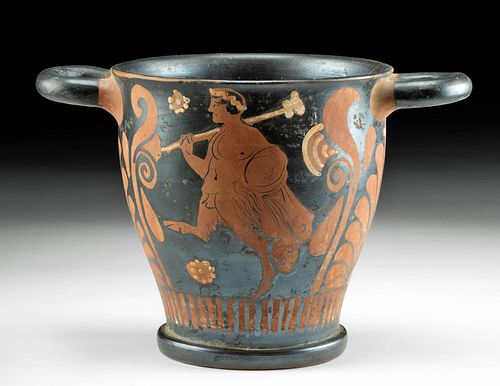Campanian Skyphos w/ Pan, Leiden Skyphoi Painter
About Seller
686 S Taylor Ave, Ste 106
Louisville, CO 80027
United States
Selling antiquities, ancient and ethnographic art online since 1993, Artemis Gallery specializes in Classical Antiquities (Egyptian, Greek, Roman, Near Eastern), Asian, Pre-Columbian, African / Tribal / Oceanographic art. Our extensive inventory includes pottery, stone, metal, wood, glass and textil...Read more
Two ways to bid:
- Leave a max absentee bid and the platform will bid on your behalf up to your maximum bid during the live auction.
- Bid live during the auction and your bids will be submitted real-time to the auctioneer.
Bid Increments
| Price | Bid Increment |
|---|---|
| $0 | $25 |
| $300 | $50 |
| $1,000 | $100 |
| $2,000 | $250 |
| $5,000 | $500 |
| $10,000 | $1,000 |
| $20,000 | $2,500 |
| $50,000 | $5,000 |
| $100,000 | $10,000 |
| $200,000 | $20,000 |
About Auction
Nov 10, 2022
Museum-worthy examples of classical antiquities (Egyptian, Greek, Roman, Near Eastern), Viking, Far East / Asian, Pre-Columbian, African / Tribal, Oceanic, Native American, Spanish Colonial, Nautical, Fossils, Ancient Jewelry, Fine / Visual Arts, so much more! Artemis Fine Arts info@artemisfinearts.com
- Lot Description
Magna Graecia, Campanian, ca. 340 BCE. Attributed to Painter of the Leiden Skyphoi. An elegant pottery skyphos depicting the goatish god Pan, here shown beardless as an ephebe, strutting left as he seemingly chases a young woman - perhaps a nymph or maenad - on the opposite side, all delineated in red figure technique with highlights in white and orange fugitive pigments. A cloak covering his left arm, the proud Pan carries a thyrsus - a pine-tipped staff typically associated with wine god Dionysus - while the draped female holds a wreath and appears to dance or run. The pair is segregated by 2 palmettes, and all is atop a band of tongues as floral and target motifs adorn the field. Pan was a pastoral god of the wild, shepherds and flocks, and rustic music and impromptus, and was typically portrayed with upper body of a man and the hindquarters, legs, and horns of a goat. A follower of Dionysus, he was noted for his salacious behavior and affection for wood nymphs, and perhaps is seen here pursuing one! Size: 9.1" W x 6" H (23.1 cm x 15.2 cm)
Pan's pursuit of nymphs was a prominent motif throughout Greek mythology. One of the most notable stories involves the wood-nymph Syrinx, daughter of the river god Ladon, who met Pan one day as she was returning from a hunt. To escape the god's importunities, she ran to her sisters who turned her into a river reed. Pan, still infatuated with the fair maiden, heard a plaintive melody blow through the reeds and decided to cut them and tie them together, thereby creating the pan flute, also known as a syrinx. In other myths, the lecherous Pan is angered by the nymph Echo, who scorned the love of any man, and instructs his followers to tear her to pieces and spread them all over the earth. All that remained was Echo's voice, which from then on repeated the last words of others.
This piece has been attributed to the Leiden Skyphoi Painter of the larger Frignano group by Royal Athena Galleries and Gorny & Mosch. Little is known of the painter, other than he was active in Campania in the 4th century BCE.
Published in Jerome M. Eisenberg and F. Williamson Price, "Art of the Ancient World - Volume XXVIII," New York: Royal-Athena Galleries, 2017, no. 112.
Provenance: ex-Royal Athena Galleries, New York City, New York, USA; ex-Gorny& Mosch, Munich, Germany, auction 235, December 16th, 2015, lot 513; ex-Gorny & Mosch, Munich, Germany, auction 194, 2010, lot 370; ex-private A.L. collection, Germany, acquired in the 1970s
All items legal to buy/sell under U.S. Statute covering cultural patrimony Code 2600, CHAPTER 14, and are guaranteed to be as described or your money back.
A Certificate of Authenticity will accompany all winning bids.
We ship worldwide and handle all shipping in-house for your convenience.
#175404Light re-outlining of figures in some areas, but done very well and barely noticeable. A few expected nicks and scratches as shown, all commensurate with age. Otherwise, intact and in excellent condition. Great preservation of detail and pigments with nice iridescence.Condition
- Shipping Info
-
Artemis Gallery will no longer be able to offer in-house shipping for most international orders, as well as all oversized orders, including most paintings. These items are clearly marked in the listing as “3rd Party Shipping Required” in the listing. We have a list of recommended third party shippers to assist you in shipping to and from, and would be happy to assist you in working with them. We require a written authorization from the client to release property to any third party. You may fax a Shipping Release Form to 303-828-3235 or email your authorization to kristen@artemisgallery.com. Please note the all property must be removed from our premises within seven (7) business days following the last day of the auction.
-
- Buyer's Premium



 EUR
EUR CAD
CAD AUD
AUD GBP
GBP MXN
MXN HKD
HKD CNY
CNY MYR
MYR SEK
SEK SGD
SGD CHF
CHF THB
THB














